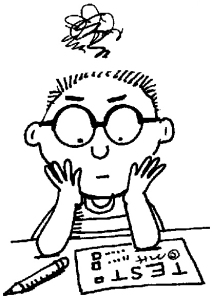Last year, I wrote an essay on the problematic nature of “teaching to the test” and the devastating effect this has had on the American education system. As the implementation of the “common core” looms before us, promising educational mediocrity and the end of innovation and creativity, I thought might post my thoughts on this important subject, whose only substantive means of evaluation will be more and more assessment tests. Yet, it doesn’t end there…the government wants to “data mine” all students, and home educators, particularly those who participate in online charter school programs, will not be immune to this invasion. As a home educator, I simply must affirm that education consists of so much more than a leveled field where all effort is expended towards the unexceptional. So…here are my thoughts, such as they are. Ignore the scholarly citations and lack of revision. I received an A on the rough as submitted and in the midst of a busy home educating week, opted to go with it, rather than fine-tune. I wrote this with many of my public school teaching friends in mind as they are pawns in this game, too…
Teaching to the Test: How Assessment Tests Are Failing American Students and Educators

“Teaching to the test” is an educational mode, born of annual assessment testing requirements, that is of no value whatsoever to students or educators. Through these performance based tests, educators are stripped of their dignity and creativity when forced to adhere to a limited academic scope that fails to demonstrate any real mastery of the subjects at hand. Students receive only cursory information deemed applicable to these assessment tests, consequently resulting in the “dumbing down” of the American educational system and concurrent poor morale among educators.
For decades, the American educational system had been acknowledged as a world leader and innovator in the academic sphere. The traditional mode of educating students through the implementation of core subject proficiency and teacher autonomy produced generations of students well-equipped to compete in college and the work force. Alas, this is no longer the case. In 2010, the United States slipped into mediocrity, falling below the mid-point in an evaluation of 34 countries. As reported by the Associated Press: “Out of 34 countries, the U.S. ranked 14th in reading, 17th in science and 25th in math,” placing this country “far behind the highest scoring countries, including South Korea, Finland and Singapore, Hong Kong and Shanghai in China and Canada” (USA Today). As troubling as these figures are, it is even more telling that among these 34 countries, only 8 have lower graduation rates than the United States. China, at the top of the list and exceeding in all three subjects, has a lower GDP (gross domestic product) than the majority of the countries in the PISA study, which shows that “Low national income does not necessarily signify poor educational performance” (PISA/OECD – 36).
This is in direct opposition to what most American taxpayers have been told: money and assessment testing equals better students. Unfortunately, the facts argue against this as none of the top performing countries spend even half of what the United States spends per student, nor do they exclusively rely upon assessment tests as the means of evaluating students and rewarding or punishing educators and schools. Only Luxembourg spends more, operating similarly to the United States, with equally abysmal student performance and one of the lowest graduation rates in the world (PISA/OECD – 30).
The impact upon students and educators, as the U.S. continues to plummet academically, is not to be underestimated. There are real people and real consequences for this devastating outcome. At the heart of this failure lies a problem, the annual assessment test, which has long been touted as the solution to what ails the American education system. There are nearly as many assessment tests as there are students. Educators utilize CTBS, ITBS, CAT, ACT, and PSAT, just to name a few, each promising to measure competency in a variety of subjects. It seems to make sense on the surface. The purpose of a test is to measure the understanding of a particular subject. Unfortunately, these tests are used not only for the evaluation of student proficiency and understanding, but are now the criteria which determine whether a teacher is successful in the classroom. Dana Goldstein, a Spencer fellow in education journalism at Columbia University, addresses this issue in “Is the U.S. Doing Teacher Reform All Wrong?” The evaluation of student and teacher proficiency is no longer simply in the hands of administrators, for as the article reveals, there are now “new state laws written in response to the Obama administration’s Race to the Top grant program, some of which base up to 51 percent of a teacher’s evaluation on student test-score data” (Goldstein).
A teacher’s job security and determination of success is now tied primarily to the student’s performance on these annual assessment tests. Is it any wonder that many schools and educators, under increased pressure from the Department of Education, are now devoting most of their efforts towards insuring that students are simply proficient or at least receive passing marks on these tests? This phenomenon has had a marked impact upon the way teachers teach, how they view their role as educator, and how they determine success in their career. The temptation to focus on these assessment tests, as a means of job security, is great.
Dawn Shirk, an English teacher in Reidsville, North Carolina, knows the real challenges that face most teachers. Excited over the prospect of a new and realistic form of teacher evaluation in her state, she nonetheless expresses her frustration that assessment tests still form the bulk of success determination:
“I have worked in schools, for example, that taught nothing but reading and math in third grade, because those were the tested areas for that year. No science was included until fifth grade, because that is when students are tested in this subject. The students might pass those tests, but what kind of education are they getting? And what will become of the low-performing schools? No good teachers will want to go there. How does this serve the students?” (Shirk)
Shirk, as an educator, raises quite a few important considerations. “Teaching to the test” is something that she has personally witnessed, and she knows that students and teachers alike ultimately lose in this mode of education.
“Evaluating Teacher Evaluation” by Jesse Rothstein, Associate Professor of Public Policy and Economics at UC-Berkley, also reveals the necessary understanding that administrators and teachers alike must have when evaluating the “luck of the draw” aspect of education. Students come to teachers with many variables: intellect, culture, proclivities and disabilities, excitement or apathy, and so forth. These variables have a tremendous impact upon teacher performance and the ultimate determination of success and failure. Assessment tests are used to determine whether the teacher has “added value” from the prior year’s performance. But, as the article outlines, many teachers reveal “they couldn’t identify a relationship between their instructional practices and their value-added ratings, which appear unpredictable” (Rothstein).
With such arbitrary results, one should ask the obvious questions: How did we get here? When did annual assessments become the gold standard by which a student and teacher’s effectiveness are measured? According to Peter Henry, “The Case against Standardized Testing,” this is a relatively recent development:
“In little more than a decade, the frequency and number of standardized tests has doubled and redoubled in response to public concern about the quality of high school graduates, and thus, the effectiveness of public school” (Henry). The fallout from heavy reliance and now insistence upon these tests has resulted in an “entire gestalt of the “accountability” movement (which) holds that teachers are not to be trusted or believed when it comes to student learning” (Henry).
It seems that the American educational system has lost sight of its original intent which is to produce generation after generation of thinkers, doers and innovators. Instead, students are expected to spit out the right answer to the right question, and educators are simply there to assure that they know how to do both. This is not education as it has been undertaken throughout history. Nor is it education, as it is understood in several of the countries which rank significantly above the United States in academics.
Consider Finland. Forty years ago, Finland implemented a comprehensive education reform program which has now placed the country significantly ahead of most nations, including the United States, Germany and Japan. These reforms are significantly different than those that have been suggested and implemented in the United States. Not by the privatization of education, nor through annual assessment tests, but “by strengthening the education profession and investing in teacher preparation and support” (Aho, Pitkänen, Sahlberg). Educators in Finland do not utilize annual assessment tests, but “make their own assessment tests, not quoting numeric grades, but using descriptive feedback, no longer comparing students with one another” which allows teachers and students to focus on “learning in a fear-free environment, in which creativity and risk-taking are encouraged” and gives them “more real freedom in time planning when they do not need have to focus on annual tests or exams” (Aho, Pitkänen, Sahlberg).
By emphasizing training for teachers and encouraging diverse modes of pedagogical instruction, as well as choosing the “best of the best,” Finland has demonstrated that teacher autonomy and creative freedom is the key to a vibrant and successful academic environment. The proof is revealed in not only Finland’s outstanding performance in mathematics, science and reading, but also in its top ranking in economic competitiveness.
When it comes to “teaching to the test,” student and teacher both lose. Educators simply must be allowed to educate, demonstrating through student grades, outside observation, projects, etc. that students are accomplishing an authentic education. It is working in Finland and it can work here, in the United States. Most educators agree that the ultimate goal of education is to produce a generation of thinkers, students engaged and excited about the subject at hand, able to speak and demonstrate proficiency through means that go beyond “fill in the bubble on this multiple choice test.” If the system fails to give teachers the freedom, encouragement and means to accomplish this end, then it has failed not only students and teachers, but society as well. For as Dorothy L. Sayers so eloquently states in “The Lost Tools of Learning:”
“What use is it to pile task on task and prolong the days of labor, if at the close the chief object is left unattained? It is not the fault of the teachers–they work only too hard already. The combined folly of a civilization that has forgotten its own roots is forcing them to shore up the tottering weight of an educational structure that is built upon sand. They are doing for their pupils the work which the pupils themselves ought to do. For the sole true end of education is simply this: to teach men how to learn for themselves; and whatever instruction fails to do this is effort spent in vain” (Sayers).
Works Cited
Aho, Erkki, Kari Pitkänen, and Pasi Sahlberg. “Policy Development and Reform Principles of Basic and Secondary Education in Finland since 1968.” Worldbank.org. World Bank Group, May 2006. Web. 23 May 2012.
Associated Press. “In Ranking, U.S. Students Trail Global Leaders.” USA Today. Gannett, 7 Dec. 2010. Web. 26 May 2012.
Goldstein, Dana. “Is the U.S. Doing Teacher Reform All Wrong?” WashingtonPost.com. The Washington Post, 31 May 2011. Web. 20 May 2012.
Henry, Peter. “The Case Against Standardized Testing.” MCTE.org. Minnesota English Journal, Fall 2007. Web. 23 May 2012. <http://www.mcte.org/journal/mej07/3Henry.pdf>.
Jesse Rothstein, et al. “Evaluating Teacher Evaluation.” Phi Delta Kappan 93.6 (2012): 8-15. Education Research Complete. Web. 20 May 2012.
Sayers, Dorothy L. “The Lost Tools of Learning.” GBT.org. Escondido Tutorial Services. Web. 23 May 2012.
Shirk, Dawn. “Test Scores Are Only a Snapshot.” The New York Times. The New York Times, 16 Jan. 2012. Web. 20 May 2012.
Strong Performers and Successful Reformers in Education: Lessons from PISA for the United States. Paris: OECD, 2011. Print.

























































 2013
2013





















































































 I am a traditional Catholic homeschooling mother of 9 children, married for 30 years to the most patient and sainted man. As converts to Catholicism in 1991, our family has only recently discovered the beauty and full expression of our beliefs in the timeless liturgy of antiquity, the Extraordinary Form also commonly referred to as the Traditional Latin Mass. An avid knitter, I also enjoy gardening, reading and immersing myself in the everyday graces of my vocation.
© All rights reserved
I am a traditional Catholic homeschooling mother of 9 children, married for 30 years to the most patient and sainted man. As converts to Catholicism in 1991, our family has only recently discovered the beauty and full expression of our beliefs in the timeless liturgy of antiquity, the Extraordinary Form also commonly referred to as the Traditional Latin Mass. An avid knitter, I also enjoy gardening, reading and immersing myself in the everyday graces of my vocation.
© All rights reserved 











Recent Comments